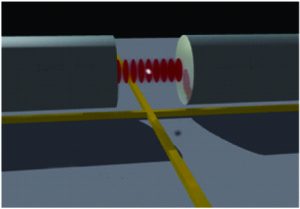Trapped-atom clock on a chip (TACC)
Typically, the performance of measurement devices is limited by deleterious effects such as thermal noise and vibration. Notable exceptions are atomic clocks, which benefit from the exquisitely stable properties of atoms and operate very near their fundamental limits. Driving devices to their physical limits will open new application spaces for civilian and defense activity. Indeed, many everyday applications already require exceptionally precise time and frequency standards enabled only by atomic clocks. The Global Positioning System (GPS), inertial navigation and telecommunication are key examples.
Thanks to (laboratory-size) atomic clocks, the second is the best realised SI unit and stunning tests of fundamental science are performed. In parallel to the search for ever higher precision, development goes towards small portable devices for mobile, in-the-field applications. Here, chip-scale atomic clocks present incredibly small size (~1 cm), but reach only moderate clock performance. Compact (litre-size) microwave clocks under development demonstrate stability down to 10-13 at 1s rivalling the traditional hydrogen-maser, but in a portable and much cheaper physics package. These are ideally suited for many civilian and defence applications, on earth and in space. Here, research can help to deploy their enormous potential and assure independence from foreign supply.
For a given atomic transition, the most efficient way of improving the clock stability is to increase the interrogation time. This is the reason for the revolutionising success of laser-cooling in metrology and has led to the construction of atomic fountain clocks and atom gravimeters. In these, the time of free fall is ~0.5 s. With the Trapped Atom Clock on a Chip (TACC), our LKB/SYRTE consortium has chosen a radically new approach, the interrogation of trapped atoms. In a first generation TACC we have validated the new concept through the discovery of interrogation times of up to 58s – a world first for neutral atoms. The current set-up reaches a very competitive clock stability of 5.8 10-13 at 1s and 6 10-15 at 30.000 s.
TACC combines the innovative techniques of atom chips and fiber Fabry-Pérot microcavities, thus we are taking a step towards the miniaturization of cold atom experiments. We will further conduct explorative studies on quantum non-destructive detection and quantum engineered spin squeezing, which will each for the first time test innovative fundamental physics approaches in a true metrology grade instrument. The expected result will put TACC in a leading position among all compact clocks and even rival the stability of the best atomic fountain clocks.
Atom Chips and Fiber Fabry-Perot Microcavity
 An exciting and fast‐growing research field has emerged at the interface of fundamental physics and technology, where the nonclassical features of quantum mechanics are employed to engineer powerful, radically new technologies. Apart from quantum cryptography – for which commercial systems are already available – quantum metrology is perhaps the one closest to real applications. High-fidelity control over light-matter coupling at the single-quantum level plays a prominent role in all quantum technologies.
An exciting and fast‐growing research field has emerged at the interface of fundamental physics and technology, where the nonclassical features of quantum mechanics are employed to engineer powerful, radically new technologies. Apart from quantum cryptography – for which commercial systems are already available – quantum metrology is perhaps the one closest to real applications. High-fidelity control over light-matter coupling at the single-quantum level plays a prominent role in all quantum technologies.
Only a small number of mechanisms are available so far to create the multiparticle entangled states that are the crucial resource of all quantum technologies. A “massively parallel” approach has given spectacular results in the last few years. Its idea is to use a high-finesse optical cavity to create an effective interaction that entangles the atoms. Entanglement experiments with such atomic ensemble CQED systems have enabled the production of spin-squeezed states, and have enabled observation of the Dicke quantum phase transition. By combining atom chip technology with the novel FFP microcavity – both developed in our group – we have been able to realize a miniature and robust platform for such experiments. This has enabled us to produce W states (a fundamental class of entangled states) and other multiparticle-entangled states enabling metrological gain. Using the exceptionally strong coupling of our FFP cavities, we have also developed one of very few quantum state tomography methods applicable to atomic qubits, which moreover provides single-qubit resolution in mesoscopic ensembles.

